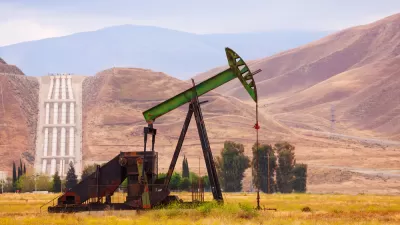Disposal of wastewater from fracking has long been associated with earthquakes in Oklahoma as well as Ohio and Texas. A new study shows they were likely the cause of a swarm of quakes in 2005 in the capital of oil in California, Kern County.
The earthquake capital of the United States is not California, as many may think, but Oklahoma, according to an analysis posted here last year. Quakes are triggered by the disposal of wastewater, a waste product from fracking, into deep injection wells. Ohio and Texas are also affected.
Ironically, the injection wells were "once considered the most environmentally responsible way for oil companies to deal with their wastewater," writes David Baker, who covers energy and clean tech for the San Francisco Chronicle.
Baker reports on a new research that reveals these man-made quakes are likely affecting Kern County, the center of California's oil production. The Golden State is the third highest oil producer in the United States, after Texas and North Dakota, which aren't as seismologically active as California.
Researchers on Thursday [Feb. 4] tied a September 2005 swarm of moderate earthquakes in Kern County to three wastewater disposal wells... The research paper, published by the American Geophysical Union, could not prove with absolute certainty that the wastewater injections caused the quakes, (B)ut the authors calculated only a 3 percent chance that the Kern County swarm was mere coincidence.
The study also does not offer any indication of how common such human-induced quakes may be in California. “However, considering the numerous active faults in California, the seismogenic consequences of even a few induced cases can be devastating,” the authors note.
How injection wells cause earthquakes
In addition to chemical-laced water used in fracking, naturally occurring ground water mixed with petroleum surfaces when drilling which "can either be treated for reuse, dumped into evaporation ponds or pumped back underground for disposal," writes Baker.
Scientists had previously tied quakes to underground injections of water into California’s geothermal energy fields, but not to injections of oil-field waste water.
Drought-plagued California recycles some of it. "Chevron piped almost 8 billion gallons of treated wastewater to almond and pistachio farmers [in 2014], according to BloombergBusiness.
The wastewater and groundwater that is not reused or sent to evaporation ponds is pumped into deep injection wells, "often into different rock formations than it came from — they can change the pressure within the rocks, making faults more likely to slip," writes Baker.
The quakes included in the new study, which struck near the Central Valley’s southern edge, weren’t large, with the most powerful registering magnitude 4.7. But injection wells have been linked elsewhere to quakes as large as magnitude 5.6, said the research paper’s lead author, Thomas Goebel, with UC Santa Cruz.
California’s oil field regulating agency — the Division of Oil, Gas and Geothermal Resources [DOGGR] — is trying to get a sense of how prevalent the problem may be, a spokesman said Thursday. The agency has commissioned Lawrence Berkeley National Laboratory to study the issue
In addition to being associated with earthquakes, DOGGR and non-profits like the Center for Biological Diversity have been researching how the disposal of wastewater from fracking could be poisoning groundwater and drinking water aquifers.
Hat tip to MTC-ABAG Library
FULL STORY: Study: Oil field operations caused California earthquakes

Trump Administration Could Effectively End Housing Voucher Program
Federal officials are eyeing major cuts to the Section 8 program that helps millions of low-income households pay rent.

Planetizen Federal Action Tracker
A weekly monitor of how Trump’s orders and actions are impacting planners and planning in America.

Ken Jennings Launches Transit Web Series
The Jeopardy champ wants you to ride public transit.

Driving Equity and Clean Air: California Invests in Greener School Transportation
California has awarded $500 million to fund 1,000 zero-emission school buses and chargers for educational agencies as part of its effort to reduce pollution, improve student health, and accelerate the transition to clean transportation.

Congress Moves to End Reconnecting Communities and Related Grants
The House Transportation and Infrastructure Committee moved to rescind funding for the Neighborhood Equity and Access program, which funds highway removals, freeway caps, transit projects, pedestrian infrastructure, and more.

From Throughway to Public Space: Taking Back the American Street
How the Covid-19 pandemic taught us new ways to reclaim city streets from cars.
Urban Design for Planners 1: Software Tools
This six-course series explores essential urban design concepts using open source software and equips planners with the tools they need to participate fully in the urban design process.
Planning for Universal Design
Learn the tools for implementing Universal Design in planning regulations.
Heyer Gruel & Associates PA
Ada County Highway District
Institute for Housing and Urban Development Studies (IHS)
City of Grandview
Harvard GSD Executive Education
Toledo-Lucas County Plan Commissions
Salt Lake City
NYU Wagner Graduate School of Public Service



























